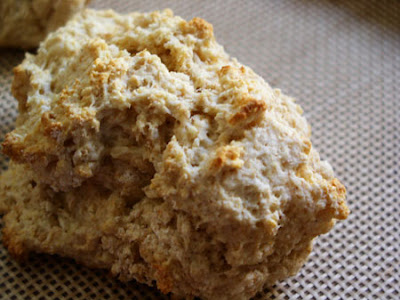Breakfast: Toasted Rice Flakes, Grapefruit.
In the modern parlance, Toasted Rice Flakes are in fact Rice Krispies. Oddly enough, sitting down to my Snap, Crackle, and Pop, it was the first time during this experiment that I felt like connected to history. With every crunchy bite of this continually popular modern cereal made me think of the fashionable patients of The San, and the subsequent breakfast cereal craze that swept the nation. Thanks, Kellogg. Your cereals are delicious.
Lunch: Green Lima Bean Toast, Banana.


I wasn’t crazy about my Lima Bean Toast. It was like complicated
adult baby food. I used frozen beans that I cooked in the microwave, then made a paste by whirling it in my food processor. I made the “white sauce,” which is just a
bechamel, and mixed the whole mess together. I spread it on some dry toast and ate it. I was unimpressed–maybe this is some Victorian mode of eating that is better left in the past.
Dinner: Macaroni Au Gratin, Mashed Sweet Potatoes, Fresh Spinach and The Queen of Puddings.


Well, it’s Wednesday, and Wednesday means Lost and Top Chef. So tonight turned into an impromptu debut dinner party with the arrival of my boyfriend and two friends. And it went well–very well.
Everything in the meal was devoured. DEVOURED. The Macaroni I made essentially to the recipe; I threw some red pepper flakes into the water that macaroni boiled in (a trick from half a century earlier). I also added a cup of cottage cheese to the sauce, because I worried it wouldn’t be cheesy enough for my guests. I sprinkled a bit of additional melted cheese on top, and sprinkled with some lightly seasoned bread crumbs. It turned out very, very well; and the entire casserole was stuffed into tummys.. But you really can’t go wrong with mac and cheese.
The mashed sweet potatoes I prepared as one does a regular potatoes, with about a quarter stick of butter and a healthy helping of cream. They were amazing. I’ve been thinking for awhile now that sweet potatoes need to be a bigger part of my life. The spinach was simple, fresh spinach from bag, with a dressing made of vinegar, oil, and brown mustard.
But then, my crowing achievement: The Queen of Puddings.

This is a recipe I was testing to go on the Dinner menu next month, and it turned out wonderfully. I made it more like a bread pudding–instead of using bread crumbs, I cubed some slightly stale bread and soaked it in the milk (and a little cream for good measure). Next I mixed in the eggs, sugar, and vanilla (a little cinnamon would not hurt, either). I put it in a 375 degree oven for 45 minutes.
In the meantime, I decided to make a fruit sauce from scratch. I sliced up some left over pineapple, and put it in a skillet with sugar, water, and a dab of water. I let it simmer for 30 minutes or so, until the pineapple was soft and the liquid had reduced.
The bread pudding came out of the over, and I poured the pineapple over top. Now for the crown!! I whipped three egg whites in my mixer until stiff peaks formed, then stirred in three tablespoons of super fine sugar. I used a spatula to spread the meringue on top of the bread pudding, and put it back into the oven at 325 degrees for 20-30. It came out IMPRESSIVE. I served it warm, contrary to the recipe’s suggestion.
 Glorious!
Glorious!
This entire dish of the Queens of Puddings was eaten, and I was showered with compliments about my culinary abilities. My non-history-nerd friends sincerely enjoyed this meal. It gave me great hope for the upcoming dinner party in March. I was worried about Kellogg’s “health food” being unappealing to a larger audience; but I also imagined there must have been a reason it so sought after a century ago.
P.S.–due to a busy schedule this week, I’ve had to write these posts fairly late at night. It has occurred to me that they may be sheer nonsense; the ramblings of a woman in a heavy cream drenched delirium. Just bare with me for two more days.
 Corn Roast. It looked exactly the same several hours later.
Corn Roast. It looked exactly the same several hours later.
















